As we noted previously, technical analysis concerns itself with the patterns created by the price quote changing throughout the day and beyond. Through the last century, studies of stock prices have supplied traders with valuable tools for evaluating those price patterns. (click here to see one of the most powerful price patterns) Triangles, tops, bottoms and so forth are no less valid in analyzing forex than they are for the stock market. There are a large number of them to be found in trading-related books and publications, and their recurrence through all sorts of different markets proves their relevance.
While using these patterns traders must always keep in mind that at any moment any unexpected event can easily disrupt a perfectly developing pattern. Indeed, in the currency market, they are very often derailed by large orders submitted for very mundane reasons: the managing of an overdue position, closing of a deal, etc. In general, it is not advisable to base one’s entire trading method on these patterns, but they do provide an excellent early-warning system for identifying a potential trade, provided that it’s backed by good causes supplied by other aspects of analysis.
The character of these patterns is the accumulation of tension and its eventual release. As we’ll see, most of these are created when the market is unsure about where to go, and is unable to break out of a particular range during a period of indecision until the crucial information is provided, uncertainty is removed and the price is free to move. The lacking information may be supplied by a news release, a government announcement, a press conference, and through myriad other possibilities.
In general, the best way to utilize these patterns is to seek them during periods of uncertainty, identifying their cause through fundamental analysis, and acting on the result.
Let’s see a few examples:
Symmetrical Triangle
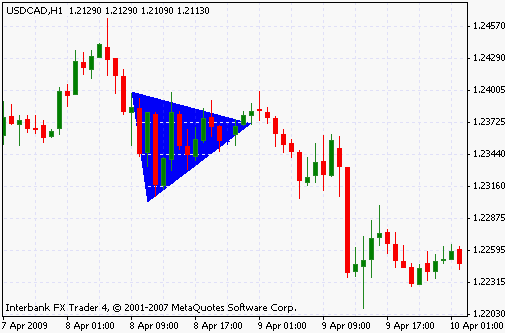
The red line here depicts the price quotes, while the blue area is, obviously, the triangle. As it can be seen from the basic graphics above triangles represent periods of consolidation; in other words, the market is going nowhere.
Triangles are in general thought to be continuation patterns: The time frame during which they develop is often a period where the market digests the previous developments, absorbs new money and awaits new data that will provide it with the trigger to continue in the previous direction. So in essence, triangles are the breather phase in a continuing run during which market participants pull back and reassess their gains or losses. At the point where a triangle develops, the market usually has not entirely priced in the main event which created the bull or bear market in the first place, and triangles can be a good entry point for a trader who has missed the beginning of the main trend, provided that the underlying fundamental picture remains the same.
The symmetrical triangle represents the case where the market is temporarily unsure about pressing the price higher or lower beyond the range established. It is thus often found on intraday charts in the period leading to major news releases. Neither money flow nor news supplies the catalyst to move the market to either direction, and the vote of the market is split. Still, the symmetrical triangle can provide a very good point for joining an existing trend, provided the fundamental picture remains the same and there’s no major development that can alter the direction.
Ascending Triangles
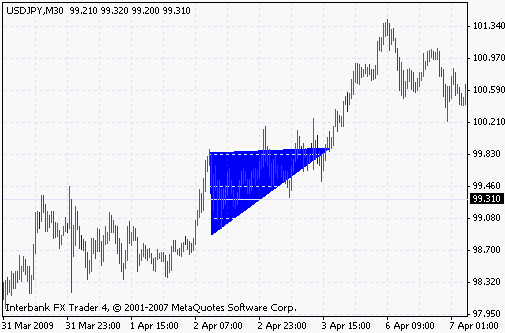
The ascending triangle represents market conditions during which the market participants are inclined to view the bullish aspect more positively. In other words, the amount of money that is buy-side is greater than the amount that is sell-side, but the difference between the two is not enough to force a breakout from the triangle pattern. It’s a sign that given a sufficiently positive signal from news flow or the infusion of a large amount of money into the market, prices will either continue or begin a new uptrend.
Traders usually interpret the ascending triangle during a bear trend as a sign of trend-reversal. It’s safe to say that it is at least a sign of indecision or exhaustion by market participants, just like all the chart patterns that we examine here. As with the symmetrical triangle we just discussed, it can provide the trader with a good entry or exit point, provided that the signals sent by technical analysis are confirmed by sound fundamental reasons. For those who’d like to base their decisions on technical analysis only, a well-planned stop-loss order is advisable, as the breakout of all triangles can be rapid and violent, causing great losses to those on the wrong side.
Descending Triangles
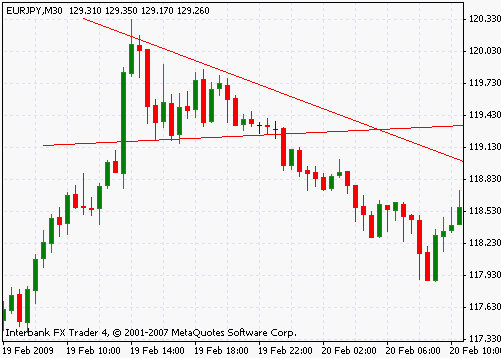
The descending triangle is the exact opposite of the ascending triangle. As a result, it’s usually found at reversal points in bull markets but also as continuation patterns during the course of bear markets. All the statements made above about the ascending triangle are also valid here, but in reverse.
Despite all the characterizations that we’ve made about these patterns, we must always keep in mind that nothing in technical analysis is guaranteed. There’s not a single indicator or pattern that offers the trader the perfect solution to the market’s uncertainties.
Double, Triple and Quadruple Bottoms and Tops
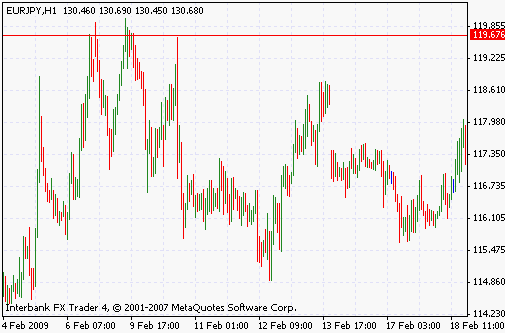
Tops and bottoms are patterns that are found when the trend is in danger of reversing. During the development of these patterns buyers and sellers are close to being in equilibrium, and the amount of money entering or exiting the market is not enough to force a breach of the support and resistance lines that define the top and bottom structure. In other words, the main trend that is being tested at the support or resistance line is in danger of exhausting itself, but is still intact as long as the pattern is developing. As with the triangle pattern, this pattern keeps zigzagging and repeating itself until news or new money forces a breach of the support or resistance level. Technical analysis contends that the greater the number of tops and bottoms, the higher the likelihood of a reversal; the stronger a support or resistance level is, the higher its potential for overcoming and reversing the trend, at least on a temporary basis.
Of course, not every top/bottom formation will lead to a reversal. In fact, as with the triangle, these formations occur ubiquitously on the intraday and intra-hour charts without having much significance beyond signalling a very brief period of consolidation for the price action. But there are times when the tops and bottoms are strongly coupled to news reports and other fundamental developments, and the trader will surely come across many cases where the market responds in quite a predictable fashion to the stimulation provided by these sources. In order to avoid whipsaws and false breakouts, the trader can always attempt to corroborate his technical scenario with information from the fundamental side.
Head and Shoulders and Reverse Head and Shoulders
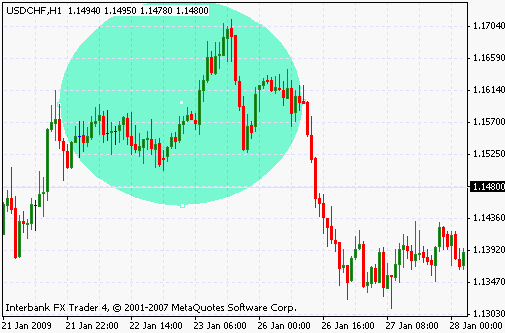
Head and shoulders patterns are in fact quite similar to top/bottom formations, with the one distinction that the second attempt at breakout (that is, the head) from the support or resistance level where the first shoulder failed is able to succeed, but then goes nowhere. In other words, the trend temporarily seems to press on with its progress, but the price movement is deceptive, and eventually the prices move back below the support or resistance line where the shoulders of the formation fail to breakout again. The trend is then expected to reverse.
The head and shoulders pattern is in general a reversal signal in a bull market, while its reverse signifies the opposite. In a sense, the market “eats” those few who, on a bout of euphoria, follow the false breakout and attempt to chase it higher, while the majority remain on the sidelines, undecided. Once it’s clear that the breakout attempt has failed, they make their own move, and the trend is reversed.
The pattern is a powerful signal and should always be considered when evaluating the price action. Of course, it’s not the compass for determining trend reversals, but it’s a significant and useful warning sign for a possible change in the market’s attitude. Find our most comprehensive article on different well known chart patterns here.
Key Points
- Chart patterns form as price quotes change throughout the day. These patterns can provide clues to how prices might change.
- Triangle patterns form during periods of consolidation, when the market is ‘taking a breather’ before deciding where to go next.
- Tops and bottoms patterns form when a trend is about to reverse and change direction.
- Head and shoulders patterns are similar to tops and bottoms patterns but have a central ‘head’ where prices temporarily break above the previous high before falling below it
Further Reading
More Free Forex Lessons
subscribe to get a FREE BONUS LESSON, plus course updates, trade ideas and market news - straight to your inbox
Forextraders' Broker of the Month
BlackBull Markets is a reliable and well-respected trading platform that provides its customers with high-quality access to a wide range of asset groups. The broker is headquartered in New Zealand which explains why it has flown under the radar for a few years but it is a great broker that is now building a global following. The BlackBull Markets site is intuitive and easy to use, making it an ideal choice for beginners.
